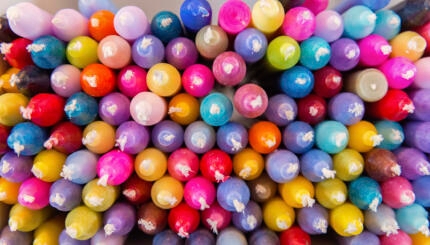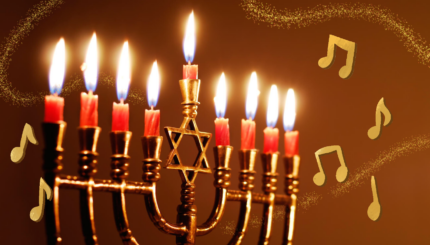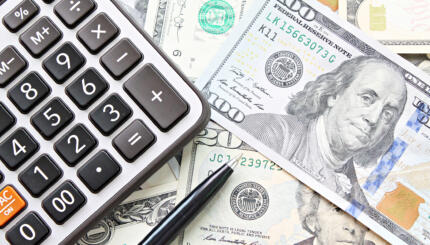It is Passover, not , that Jews call “the festival of our freedom.” Among Jews in the Western countries in the late 19th century, though, that minor winter festival had come to be identified as a celebration of religious liberty.
Traditionally, the focus of Hanukkah was on the divine miracle worked for the priests who restored the purity of the Holy Temple in Jerusalem after its liberation from Hellenistic foreign rulers. The holiday was considered a triumph of the Maccabees and their dedication to Temple rites and the primacy of Jewish law. But as the liberal regimes of Western Europe and America began in the 1800s to champion modern notions of religious tolerance and freedom, the Jews of those nations began to see Hanukkah as a celebration of those very values.
Hymn of the New Hanukkah
Liberal liturgist Leopold Stein (1810-1882) gave classic expression to this new outlook in a German hymn sung to the traditional German melody for the medieval Hanukkah song Ma’oz Tsur.
The lyrics of the traditional hymn recounted the repeated pattern of the Jewish people being rescued by God from foreign regimes who sought to subjugate or even obliterate them. In contrast, the theme of Stein’s work is the universal liberation of humanity from the tyranny of oppressive regimes. The uprising of the Jews under the leadership of the Hasmonean priests (the Maccabees and their descendants) against their Syrian-based overlords serves as a model of an ostensibly weak people, living under occupation by a ruthless world power, who nonetheless prevail in their war of national liberation.
With your help, My Jewish Learning can provide endless opportunities for learning, connection and discovery.
For the mid-sized and smaller ethnic groups of Europe struggling to establish their own states along ethnic and, frequently, religious lines in a world controlled by Habsburg emperors, Kaisers, and other imperial rulers, the message was (to cite a popular adage): the Jews are just like everyone else, but more so. In this case, the “more so” is that they anticipated the trend by nearly two millennia. To Stein and those who thought like him, the Jews therefore became the original fighters for religious tolerance, serving as the model for those who would later champion that cause.
That German hymn was translated into English by two scholarly Central European rabbis living in the United States, Marcus Jastrow (1829-1903) and Gustav Gottheil (1827-1903). It achieved wide recognition and appears in many 20th-century Jewish prayerbooks, across denominational lines. In this version, the song declares:
Rock of Ages, let our song
Praise Thy saving power;
Thou, amidst the raging foes,
Wast our sheltering tower.
Furious they assailed us,
But Thine arm availed us,
And Thy Word
Broke their sword
When our own strength failed us.
Kindling new the holy lamps,
Priests, approved in suffering,
Purified the nation’s shrine,
Brought to God their offering.
And His courts surrounding
Hear, in joy abounding,
Happy throngs,
Singing songs
With a mighty sounding.
Children of the martyr race,
Whether free or fettered,
Wake the echoes of the songs
Where ye may be scattered.
Yours the message cheering
That the time is nearing
Which will see
All men free,
Tyrants disappearing.
The contrast with the traditional Hebrew hymn is striking. Gone is the uniqueness of the Jewish experience of repeated persecution. The divine rescue is not the preservation of God’s unique, covenanted nation but a harbinger of what will transpire for all the nations of the world: liberation and self-determination.
Generations of Jews raised in the Western world, where the uniquely Christian message of Christmas dominated public spaces despite the Enlightenment promise of a religiously neutral society, found in Hanukkah a response to that challenge. Jews took the opportunity of their own December holiday to assert the value of religious freedom, the right of a minority to live according to its own religious values and practices. Understood this way, Hanukkah provided the Jews a way to say, “We, too, belong in this society. We, too, have something unique and valuable to contribute–valuable to the world, and not just to us.”
Candle of Peace
The Jewish heritage came to be presented in such universal terms in sermons and liturgical passages, and even in popular song. Peter Yarrow, the eponymous member of the mid- to late 20th-century musical trio “Peter, Paul, and Mary,” penned a Hanukkah song, “Light One Candle,” that reflects a later version of this outlook. Nothing uniquely Jewish is at stake in the story of Hanukkah. “Justice and freedom,” in the abstract, are what must be preserved by the valorous Maccabees whose very “right to exist was denied.”
The unnamed person(s) addressed in the lyrics are told to “light one candle” (not eight) for the Maccabees, whose generically vague “light” was never extinguished. Somehow, this will also advance the cause of peace:
Light one candle for the Maccabee children
With thanks that their light didn’t die.
Light one candle for the pain they endured
When their right to exist was denied.
Light one candle for the terrible sacrifice
Justice and freedom demand.
But light one candle for the wisdom to know
When the peacemaker’s time is at hand.
Don’t let the light go out!
It’s lasted for so many years!
Don’t let the light go out!
Let it shine through our love and our tears. […]
Echoing what could be the questions asked by an assimilated Jew who knows that Hanukkah is celebrated by lighting candles but realizes that he or she is unaware of their significance, the song asks:
What is the memory that’s valued so highly
That we keep it alive in that flame?
What’s the commitment to those who have died
That we cry out they’ve not died in vain?
The answer provided is no more specifically related to the story of the Hasmonean revolt or to traditional Jewish value-concepts than was the question:
We have come this far always believing
That justice would somehow prevail.
This is the burden, this is the promise,
This is why we will not fail!
Hanukkah in America, like most Jews in America, had come to be identified closely with the values of liberal democracy. While for some American Jews, it seems, any uniquely Jewish message in that holiday had become invisible, we may also say that many Jews were able to envision their own struggle for autonomy as part of a larger, worldwide trend.


